Electroejaculation is a technique that can be used to collect semen from canines, but its use with this group of animals is restricted by low success rate and low semen quality.
METHODS AND RESULTS:
Here, we evaluated whether pharmacological and sexual sensory stimuli, which may affect ejaculation, can increase electroejaculation efficiency and improve ejaculate quality. We worked with 20 dogs of mixed breed weighing between 5.3 and 22.2 kg, divided into two groups. Both groups were exposed to a spayed female for 10 min, but in the second group, the same spayed female had her vagina impregnated with Methyl 4-hydroxybenzoate synthetic pheromone for 10 min and after receiving dinoprost tromethamine IM, 0.1 mg/kg. After stimulation, all dogs were chemically restrained with ketamine, 8 mg/kg, IM; and xylazine, 1 mg/kg, IM, and subjected to electroejaculation protocol. We obtained 100% of antegrade ejaculate in treatments when the spayed female had her vagina impregnated with pheromone and 80% when she did not. Sperm motility was significantly different (p < 0.05) between controls and the test group (10.1 ± 4.5 and 43.0 ± 8.3, respectively).
CONCLUSIONS:
We concluded that the adopted electroejaculation protocol was efficient and that the PGF2α associated with sexual sensory stimulation can improve semen quality in dogs undergoing the procedure. |






 Cell. 2018 Jan 11;172(1-2):249-261.e12. doi: 10.1016/j.cell.2017.12.019.IF=36.216(2019)
Cell. 2018 Jan 11;172(1-2):249-261.e12. doi: 10.1016/j.cell.2017.12.019.IF=36.216(2019) Cell Metab. 2020 Mar 3;31(3):534-548.e5. doi: 10.1016/j.cmet.2020.01.002.IF=22.415(2019)
Cell Metab. 2020 Mar 3;31(3):534-548.e5. doi: 10.1016/j.cmet.2020.01.002.IF=22.415(2019) Mol Cell. 2017 Nov 16;68(4):673-685.e6. doi: 10.1016/j.molcel.2017.10.022.IF=14.548(2019)
Mol Cell. 2017 Nov 16;68(4):673-685.e6. doi: 10.1016/j.molcel.2017.10.022.IF=14.548(2019)